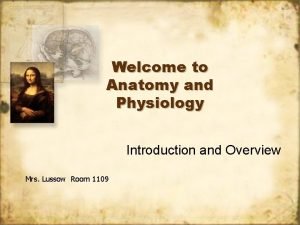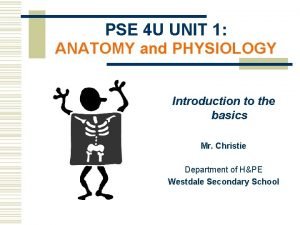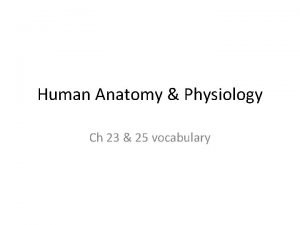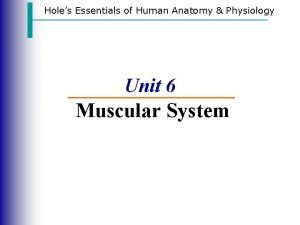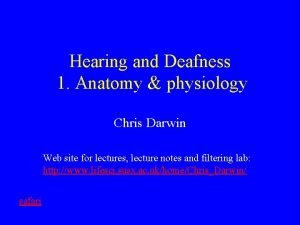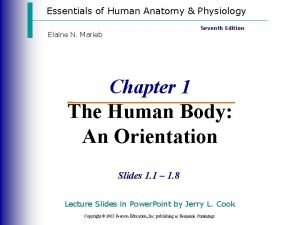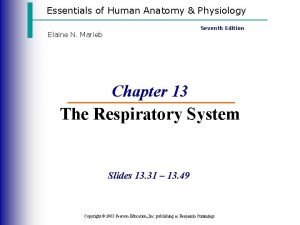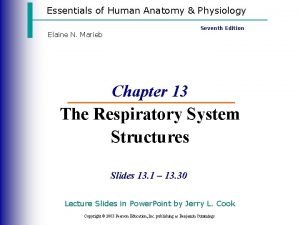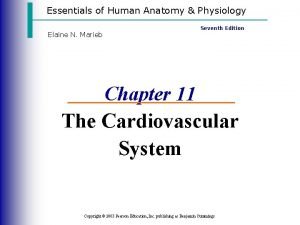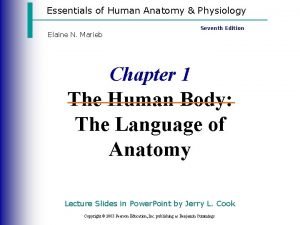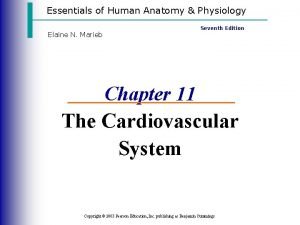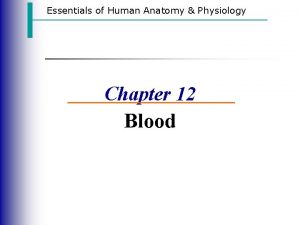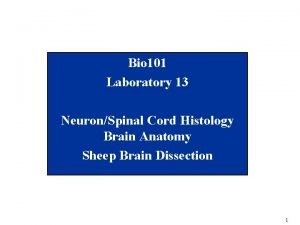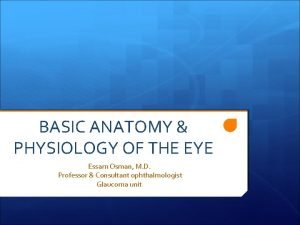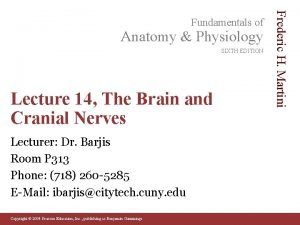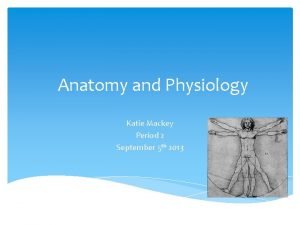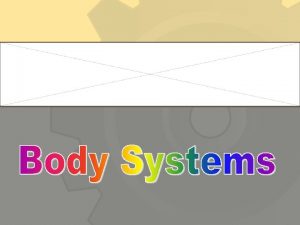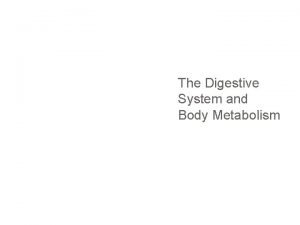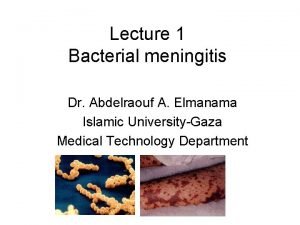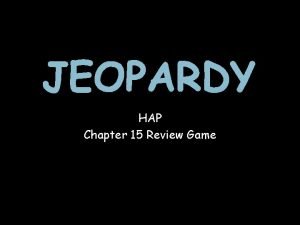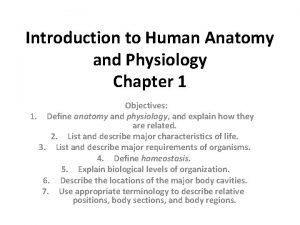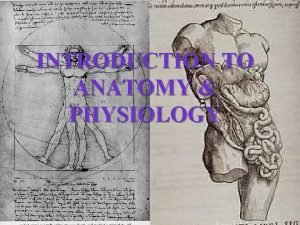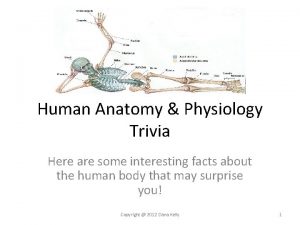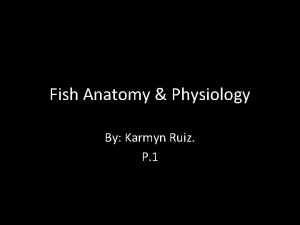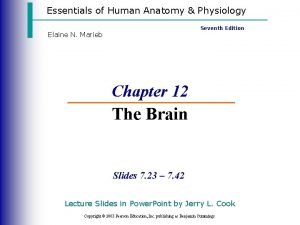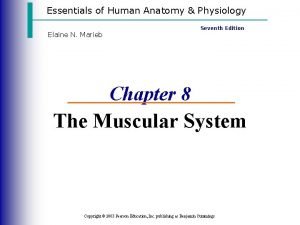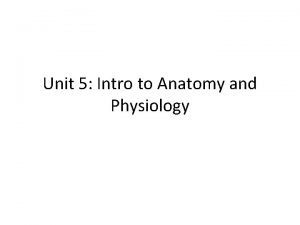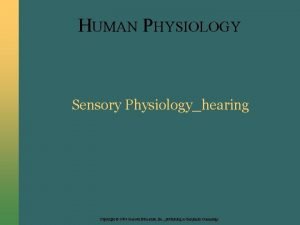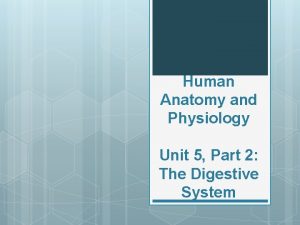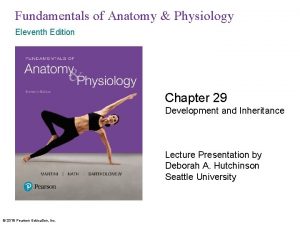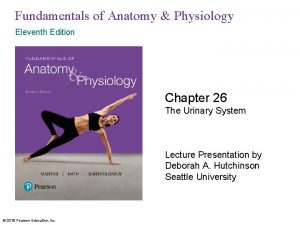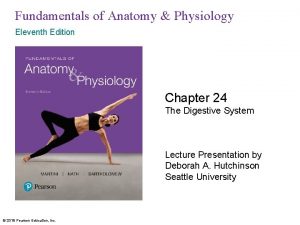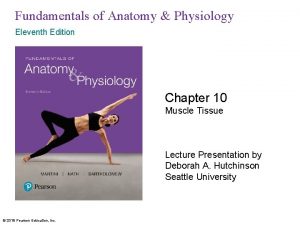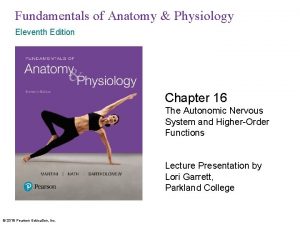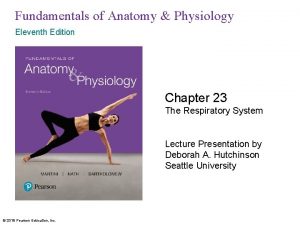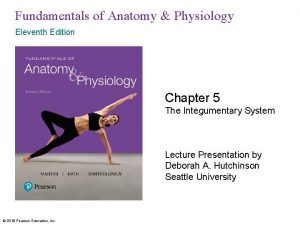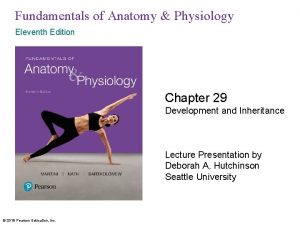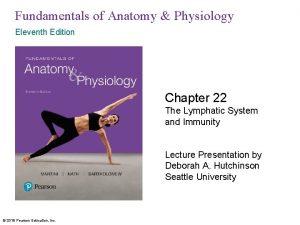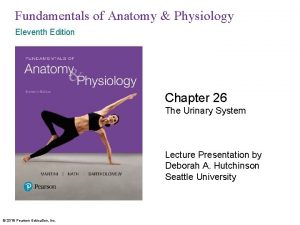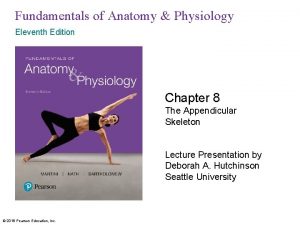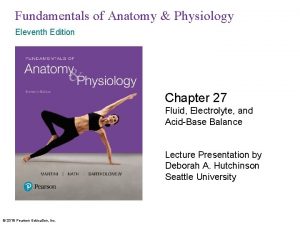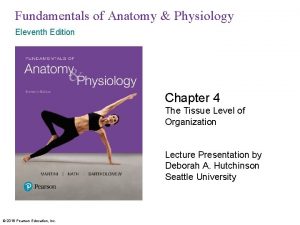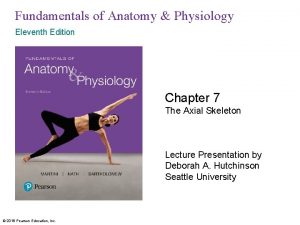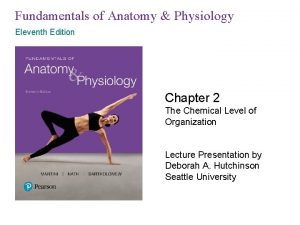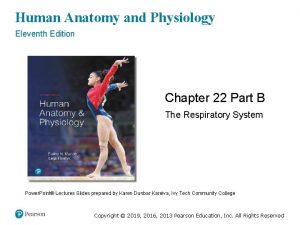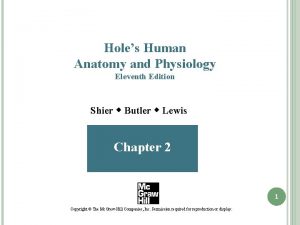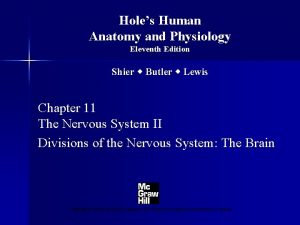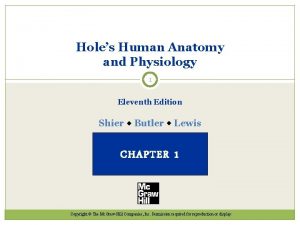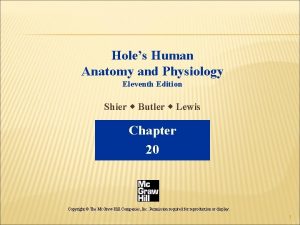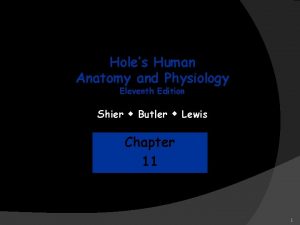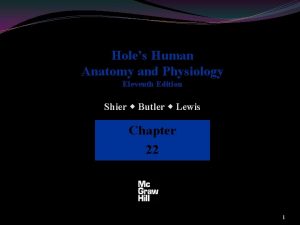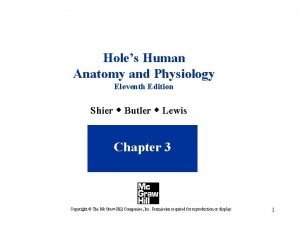Fundamentals of Anatomy Physiology Eleventh Edition Chapter 9

































































































- Slides: 97

Fundamentals of Anatomy & Physiology Eleventh Edition Chapter 9 Joints Lecture Presentation by Deborah A. Hutchinson Seattle University © 2018 Pearson Education, Inc.

Learning Outcomes 9 -1 Contrast the major categories of joints, and explain the relationship between structure and function for each category. 9 -2 Describe the basic structure of a synovial joint, and describe common synovial joint accessory structures and their functions. 9 -3 Describe how the anatomical and functional properties of synovial joints permit movements of the skeleton. 9 -4 Describe the joints between the vertebrae of the vertebral column. 2 © 2018 Pearson Education, Inc.

Learning Outcomes 9 -5 Describe the structure and function of the elbow joint and the knee joint. 9 -6 Describe the structure and function of the shoulder joint and the hip joint. 9 -7 Describe the effects of aging on joints, and discuss the most common age-related clinical problems for joints. 9 -8 Explain the functional relationships between the skeletal system and other body systems. 3 © 2018 Pearson Education, Inc.

An Introduction to Joints § Joints (articulations) – Where two bones meet – Where body movement occurs § A tradeoff exists between strength and mobility 4 © 2018 Pearson Education, Inc.

9 -1 Classification of Joints § Two classification schemes – Structural (anatomy) – Functional (range of motion) § Joint structure determines function 5 © 2018 Pearson Education, Inc.

9 -1 Classification of Joints § Structural classifications – Fibrous – Cartilaginous – Bony – Synovial § Functional classifications – Synarthrosis (immovable joint) – Amphiarthrosis (slightly movable joint) – Diarthrosis (freely movable joint) 6 © 2018 Pearson Education, Inc.

9 -1 Classification of Joints § Synarthrosis (immovable joint) – Very strong – Edges of bones may touch or interlock – May be fibrous or cartilaginous – Four types of synarthrotic joints • Suture • Gomphosis • Synchondrosis • Synostosis 7 © 2018 Pearson Education, Inc.

9 -1 Classification of Joints § Synarthrosis – Suture • Found only between bones of skull • Edges of bones interlock • Bound by dense fibrous connective tissue – Gomphosis • Binds teeth to bony sockets • Fibrous connection (periodontal ligament) 8 © 2018 Pearson Education, Inc.

9 -1 Classification of Joints § Synarthrosis – Synchondrosis • Rigid cartilaginous bridge between two bones • Found between vertebrosternal ribs and sternum • Also, epiphyseal cartilage of growing long bones – Synostosis • Created when two bones fuse • Example: metopic suture of frontal bone • And epiphyseal lines of mature long bones 9 © 2018 Pearson Education, Inc.

9 -1 Classification of Joints § Amphiarthrosis – More movable than a synarthrosis – Stronger than a diarthrosis – May be fibrous or cartilaginous – Two types of amphiarthroses • Syndesmosis—bones connected by a ligament • Symphysis—bones connected by fibrocartilage 10 © 2018 Pearson Education, Inc.

9 -2 Synovial Joints § Synovial joints (diarthroses) – Freely movable joints – At ends of long bones – Surrounded by joint capsule (articular capsule) • Contains synovial membrane – Synovial fluid from synovial membrane • Fills joint cavity – Articular cartilage covers articulating surfaces • Prevents direct contact between bones 11 © 2018 Pearson Education, Inc.

Figure 9– 1 a The Structure of a Synovial Joint. Medullary cavity Spongy bone Periosteum Components of Synovial Joints Fibrous joint capsule Synovial membrane Articular cartilages Joint cavity (contains synovial fluid) Ligament Metaphysis Compact bone a Synovial joint, sagittal section 12

Figure 9– 1 b The Structure of a Synovial Joint. Quadriceps tendon Patella Joint capsule Synovial membrane Joint cavity Femur Accessory Structures of a Knee Joint Bursa Fat pad Meniscus Articular cartilage Tibia b Knee joint, sagittal section Ligaments Extracapsular ligament (patellar) Intracapsular ligament (cruciate) 13

9 -2 Synovial Joints § Synovial fluid – Has the consistency of egg yolk – Contains proteoglycans – Primary functions include • Lubrication • Nutrient distribution • Shock absorption 14 © 2018 Pearson Education, Inc.

9 -2 Synovial Joints § Synovial joints are mobile but relatively weak § Stabilized by accessory structures – Cartilages and fat pads – Ligaments – Tendons – Bursae 15 © 2018 Pearson Education, Inc.

9 -2 Synovial Joints § Cartilages – Meniscus—fibrocartilage pad between opposing bones § Fat pads – Adipose tissue covered by synovial membrane – Protect articular cartilages § Ligaments – Support and strengthen joints – Sprain—ligament with torn collagen fibers 16 © 2018 Pearson Education, Inc.

9 -2 Synovial Joints § Tendons – Attach to muscles around joint § Bursae – Small pockets of synovial fluid – Cushion areas where tendons or ligaments rub against other tissues 17 © 2018 Pearson Education, Inc.

9 -2 Synovial Joints § Factors that stabilize synovial joints – Prevent injury by limiting range of motion • Collagen fibers of joint capsule and ligaments • Shapes of articulating surfaces and menisci • Other bones, muscles, or fat pads • Tendons attached to articulating bones 18 © 2018 Pearson Education, Inc.

9 -3 Movements at Synovial Joints § Movements are described in terms that reflect the – Plane or direction of movement – Relationship between structures § Planes of movement – Monaxial— 1 plane (e. g. , elbow) – Biaxial— 2 planes (e. g. , wrist) – Triaxial— 3 planes (e. g. , shoulder) 19 © 2018 Pearson Education, Inc.

9 -3 Movements at Synovial Joints § Types of movement at synovial joints – Gliding movement – Angular movement – Circumduction – Rotational movement – Special movements 20 © 2018 Pearson Education, Inc.

Figure 9– 2 Joint Movement (Part 1 of 12). Simple Model of Articular Motion Take a pencil as your model and stand it upright on the surface of a desk. The pencil represents a bone, and the desk is an articular surface. A lot of twisting, pushing, and pulling will demonstrate that there are only three ways to move the pencil. 21

Figure 9– 2 Joint Movement (Part 2 of 12). Moving the Point Linear motion Possible movement 1 shows the pencil can move. If you hold the pencil upright, without securing the point, you can push the pencil across the surface. This kind of motion is called gliding. You could slide the point forward or backward, from side to side, or diagonally. 22

Figure 9– 2 Joint Movement (Part 3 of 12). Changing the Shaft Angle Angular motion Possible movement 2 shows the pencil shaft can change its angle with the surface. With the tip held in position, you can move the eraser end of the pencil forward and backward, from side to side, or at some intermediate angle. 23

Figure 9– 2 Joint Movement (Part 4 of 12). Changing the Shaft Angle Circumduction A more complex angular motion is possible. Grasp the pencil eraser and move the pencil in any direction until it is no longer vertical. Now, swing the eraser through a complete circle in a movement called circumduction. 24

Figure 9– 2 Joint Movement (Part 5 of 12). Rotating the Shaft Rotation Possible movement 3 shows that the pencil shaft can rotate. If you keep the shaft vertical and the point at one location, you can still spin the pencil around its longitudinal axis in a movement called rotation. No joint can freely rotate because this would tangle blood vessels, nerves, and muscles, as they crossed the joint. 25

Figure 9– 2 Joint Movement (Part 6 of 12). Axes of Motion Movement of joints can also be described by the number of axes that they can rotate around. A joint that permits movement around one axis is called monaxial, a joint that permits movement around two axes is called biaxial, and one that permits movement around three axes, is called triaxial. Superior–inferior axis Lateral–medial axis Anterior–posterior axis 26

9 -3 Movements at Synovial Joints § Gliding movement – When two flat surfaces slide past each other – Example: between carpal bones 27 © 2018 Pearson Education, Inc.

9 -3 Movements at Synovial Joints § Angular movement – Flexion and extension are movements in the anterior– posterior plane – Flexion • Decreases angle between articulating bones – Extension • Increases angle between articulating bones – Hyperextension • Extension past anatomical position 28 © 2018 Pearson Education, Inc.

Figure 9– 3 a Angular Movements and Circumduction. Extension Flexion Hyperextension Flexion Extension Hyperextension Extension Flexion Hyperextension Extension a Flexion/extension 29

9 -3 Movements at Synovial Joints § Angular movement – Abduction and adduction are movements in the frontal plane – Abduction • Movement away from longitudinal axis – Adduction • Movement toward longitudinal axis 30 © 2018 Pearson Education, Inc.

Figure 9– 3 b Angular Movements and Circumduction. Abduction Adduction b Abduction/adduction relative to the midline of the body 31

Figure 9– 3 c Angular Movements and Circumduction. Adduction Abduction c Adduction/abduction relative to central digit 32

9 -3 Movements at Synovial Joints § Circumduction – A complete circular movement without rotation 33 © 2018 Pearson Education, Inc.

Figure 9– 3 d Angular Movements and Circumduction. d Circumduction 34

9 -3 Movements at Synovial Joints § Rotational movement – Rotation in reference to anatomical position • Example: left or right rotation of head – Limb rotation is relative to longitudinal axis of body • Medial rotation (internal rotation toward long axis) • Lateral rotation (external rotation away from body) 35 © 2018 Pearson Education, Inc.

Figure 9– 4 a Rotational Movements. Head rotation Right rotation Left rotation Atlanto-axial joint Lateral (external) rotation Medial (internal) rotation a Rotation 36

9 -3 Movements at Synovial Joints § Rotational movement – Pronation • Rotates forearm so that radius rolls across ulna • Results in palm facing posteriorly – Supination • Turns palm anteriorly • Forearm is supinated in anatomical position 37 © 2018 Pearson Education, Inc.

Figure 9– 4 b Rotational Movements. Supination Pronation b Supination/pronation Supination Pronation 38

9 -3 Movements at Synovial Joints § Special movements – Inversion • Twists sole of foot medially – Eversion • Twists sole of foot laterally – Dorsiflexion • Flexion at ankle (lifting toes) – Plantar flexion • Extension at ankle (pointing toes) 39 © 2018 Pearson Education, Inc.

Figure 9– 5 a Special Movements. a Eversion Inversion 40

Figure 9– 5 b Special Movements. Dorsiflexion (flexion at ankle) Plantar flexion (extension at ankle) b 41

9 -3 Movements at Synovial Joints § Special movements – Opposition • Movement of thumb toward palm or other fingers – Reposition • Opposite of opposition – Protraction • Anterior movement in horizontal plane (forward) – Retraction • Opposite of protraction (pulling back) 42 © 2018 Pearson Education, Inc.

Figure 9– 5 c Special Movements. c Opposition 43

Figure 9– 5 d Special Movements. d Retraction Protraction 44

9 -3 Movements at Synovial Joints § Special movements – Depression • Moving a structure inferiorly (down) – Elevation • Moving a structure superiorly (up) – Lateral flexion • Bending vertebral column to the side 45 © 2018 Pearson Education, Inc.

Figure 9– 5 e Special Movements. e Depression Elevation 46

Figure 9– 5 f Special Movements. f Lateral flexion 47

9 -3 Movements at Synovial Joints § Classification of synovial joints – Plane (gliding) – Hinge – Condylar (ellipsoid) – Saddle – Pivot – Ball-and-socket 48 © 2018 Pearson Education, Inc.

9 -3 Movements at Synovial Joints § Plane joint (gliding joint) – Flattened or slightly curved surfaces – Limited motion (nonaxial) § Hinge joint – Angular motion in a single plane (monaxial) § Condylar joint – Oval articular face within a depression – Motion in two planes (biaxial) 49 © 2018 Pearson Education, Inc.

Figure 9– 2 Joint Movement (Part 7 of 12). Plane joints, or gliding joints, have flattened or slightly curved surfaces that slide across one another, but the amount of movement is very slight. Movement: Gliding. Slight nonaxial le lavic C Manubrium Examples: • Acromioclavicular and claviculosternal joints • Intercarpal joints • Vertebrocostal joints • Sacro-iliac joints 50

Figure 9– 2 Joint Movement (Part 8 of 12). Hinge joints permit angular motion in a single plane, like the opening and closing of a door. Movement: Angular. Monaxial Humerus Ulna Examples: • Elbow joint • Knee joint • Ankle joint • Interphalangeal joint 51

Figure 9– 2 Joint Movement (Part 9 of 12). Condylar joints, or ellipsoid joints, have an oval articular face nestled within a depression on the opposing surface. Movement: Angular. Biaxial Radius Examples: • Radiocarpal joint Scaphoid • Metacarpophalangeal bone joints 2– 5 • Metatarsophalangeal Ulna joints 52

9 -3 Movements at Synovial Joints § Saddle joint – Articular faces fit together like a rider in a saddle – Biaxial § Pivot joint – Rotation only – Monaxial § Ball-and-socket joint – Round head in a cup-shaped depression – Triaxial 53 © 2018 Pearson Education, Inc.

Figure 9– 2 Joint Movement (Part 10 of 12). Saddle joints have complex articular faces and fit together like a rider in a saddle. Each face is concave along one axis and convex along the other. Movement: Angular. Biaxial III II Metacarpal bone of thumb Examples: • First carpometacarpal joint Trapezium 54

Figure 9– 2 Joint Movement (Part 11 of 12). Pivot joints only permit rotation. Movement: Rotation. Monaxial Examples: Atlas • Atlanto-axial joint • Proximal radio-ulnar joint Axis 55

Figure 9– 2 Joint Movement (Part 12 of 12). Ball-and-socket joint In a ball-and-socket joint, the round head of one bone rests within a cup-shaped depression in another. Movement: Angular, circumduction, and rotation. Triaxial Scapula Examples: • Shoulder joint • Hip joint Humerus 56

9 -4 Intervertebral Joints § Intervertebral joints – First two cervical vertebrae are joined by a synovial joint – Synovial joints lie between adjacent articular processes – Adjacent vertebral bodies form symphyses 57 © 2018 Pearson Education, Inc.

9 -4 Intervertebral Joints § Intervertebral disc – Separates vertebral bodies – Anulus fibrosus • Tough outer layer of fibrocartilage • Attaches disc to vertebrae – Nucleus pulposus • Elastic, gelatinous core • Absorbs shocks – Vertebral end plates of cartilage • Cover superior and inferior surfaces of disc 58 © 2018 Pearson Education, Inc.

9 -4 Intervertebral Joints § Damage to intervertebral discs – Bulging disc • Bulge in anulus fibrosus • Invades vertebral canal – Herniated disc • Nucleus pulposus breaks through anulus fibrosus • Compresses spinal nerves 59 © 2018 Pearson Education, Inc.

Clinical Note 9 -1 a Damage to Intervertebral Discs. T 12 Normal intervertebral disc L 1 Bulging disc L 2 a A lateral view of the lumbar region of the spinal column, showing a bulging intervertebral disc 60

Clinical Note 9 -1 b Damage to Intervertebral Discs. Compressed area of spinal nerve Spinal cord Nucleus pulposus of herniated disc Anulus fibrosus b A sectional view through a herniated disc, showing the release of the nucleus pulposus and its effect on the spinal cord and adjacent spinal nerves 61

9 -4 Intervertebral Joints § As vertebral column moves – Nucleus pulposus compresses – Disc shape conforms to motion § Intervertebral ligaments – Bind vertebrae together – Stabilize the vertebral column 62 © 2018 Pearson Education, Inc.

9 -4 Intervertebral Joints • Intervertebral ligaments – Ligamenta flava • Connect laminae of adjacent vertebrae – Posterior longitudinal ligament • Connects posterior surfaces of vertebral bodies – Anterior longitudinal ligament • Connects anterior surfaces of vertebral bodies 63 © 2018 Pearson Education, Inc.

Figure 9– 6 a Intervertebral Joints. Superior articular process Intervertebral Ligaments Ligamenta flava Posterior longitudinal ligament Anterior longitudinal ligament a Anterior view 64

9 -4 Intervertebral Joints § Intervertebral ligaments – Interspinous ligaments • Connect spinous processes of adjacent vertebrae – Supraspinous ligament • Connects tips of spinous processes (C 7 to sacrum) • Continuous with ligamentum nuchae (C 7 to skull) 65 © 2018 Pearson Education, Inc.

Figure 9– 6 b Intervertebral Joints. Superior articular facet Intervertebral Disc Intervertebral foramen Vertebral end plate Anulus fibrosus Nucleus pulposus Spinal cord Spinal nerve b Lateral and sectional view 66

9 -4 Intervertebral Joints § Vertebral movements – Flexion – Extension – Lateral flexion – Rotation 67 © 2018 Pearson Education, Inc.

9 -5 Elbow and Knee Joints § Elbow joint – Hinge joint – Articulations involve humerus, radius, and ulna 68 © 2018 Pearson Education, Inc.

9 -5 Elbow and Knee Joints § Joints of the elbow – Humero-ulnar joint • Largest, strongest joint at elbow • Between trochlea of humerus and trochlear notch of ulna • Limited movement – Humeroradial joint • Smaller joint • Articulation between capitulum of humerus and head of radius 69 © 2018 Pearson Education, Inc.

9 -5 Elbow and Knee Joints § Structures of the elbow – Biceps brachii muscle • Attaches to radial tuberosity • Controls elbow motion – Elbow ligaments • Radial collateral • Anular • Ulnar collateral 70 © 2018 Pearson Education, Inc.

Figure 9– 7 a The Right Elbow Joint Showing Stabilizing Ligaments. Humerus Radial collateral ligament Radial tuberosity Antebrachial interosseous membrane Radius Ulna Capitulum Anular ligament (covering head and neck of radius) a Lateral view 71

Figure 9– 7 b The Right Elbow Joint Showing Stabilizing Ligaments. Tendon of biceps brachii muscle Anular ligament Humerus Articular capsule Antebrachial interosseous membrane Medial epicondyle Ulnar collateral ligament Radius Ulna Olecranon of ulna b Medial view 72

9 -5 Elbow and Knee Joints § Knee joint – Complex hinge joint – Transfers weight from femur to tibia – Three articulations • Two femur–tibia articulations – At medial and lateral condyles • One between patella and patellar surface of femur 73 © 2018 Pearson Education, Inc.

9 -5 Elbow and Knee Joints § Joint capsule and joint cavity of knee – Medial and lateral menisci • Fibrocartilage pads • At femur–tibia articulations • Cushion and stabilize joint 74 © 2018 Pearson Education, Inc.

9 -5 Elbow and Knee Joints • Seven major supporting ligaments 1. Patellar ligament (anterior) 2. & 3. Two popliteal ligaments (posterior) 4. & 5. Anterior and posterior cruciate ligaments (inside joint capsule) 6. & 7. Tibial collateral ligament (medial) and fibular collateral ligament (lateral) 75 © 2018 Pearson Education, Inc.

Figure 9– 8 a The Right Knee Joint. Quadriceps tendon Patellar retinaculae Ligaments that Stabilize the Knee Joint Tibial collateral ligament Patellar ligament Fibular collateral ligament Fibula Tibia a Anterior view, superficial layer 76

Figure 9– 8 b The Right Knee Joint. Patellar surface Ligaments that Stabilize the Knee Joint Posterior cruciate ligament Anterior cruciate ligament Lateral condyle Medial condyle Tibial collateral ligament Menisci Medial Fibular collateral ligament Tibia Cut tendon of biceps femoris muscle Lateral Fibula b Deep anterior view, flexed 77

Figure 9– 8 c The Right Knee Joint. Gastrocnemius muscle, medial head Femur Plantaris muscle Gastrocnemius muscle, lateral head Ligaments that Stabilize the Knee Joint Bursa Tibial collateral ligament Joint capsule Fibular collateral ligament Popliteal ligaments Popliteus muscle Tibia Cut tendon of biceps femoris muscle Fibula c Posterior view, superficial layer 78

Figure 9– 8 d The Right Knee Joint. Femur Ligaments that Stabilize the Knee Joint Anterior cruciate ligament Posterior cruciate ligament Fibular collateral ligament Medial condyle Lateral condyle Menisci Lateral Medial Cut tendon Tibia Fibula d Deep posterior view, extended 79

9 -6 Shoulder and Hip Joints § Shoulder joint (glenohumeral joint) – Ball-and-socket diarthrosis – Between head of humerus and glenoid cavity of scapula – Greatest range of motion of any joint – Most frequently dislocated joint – Supported by skeletal muscles, tendons, and ligaments 80 © 2018 Pearson Education, Inc.

9 -6 Shoulder and Hip Joints § Joint capsule and joint cavity of shoulder – Glenoid labrum • Rim of fibrocartilage • Extends beyond bony rim and deepens socket of glenoid cavity – Acromion and coracoid process of scapula • Project laterally, superior to humerus • Help stabilize the joint 81 © 2018 Pearson Education, Inc.

9 -6 Shoulder and Hip Joints § Shoulder ligaments – Acromioclavicular – Coraco-acromial – Coracohumeral – Glenohumeral § Shoulder separation – Partial or complete dislocation of acromioclavicular joint 82 © 2018 Pearson Education, Inc.

9 -6 Shoulder and Hip Joints § Muscles of rotator cuff – Supraspinatus – Infraspinatus – Teres minor – Subscapularis § Shoulder bursae – Subdeltoid – Subcoracoid – Subacromial – Subscapular 83 © 2018 Pearson Education, Inc.

Figure 9– 9 a The Shoulder Joint. Acromioclavicular ligament Tendon of supraspinatus muscle Coraco-acromial ligament Coracoclavicular ligaments Clavicle Acromion Articular capsule Subdeltoid bursa Coracoid process Scapula Synovial membrane Articular cartilages Humerus Joint cavity Glenoid labrum Articular capsule a Anterior view, frontal section 84

Figure 9– 9 b The Shoulder Joint. Ligaments Stabilizing the Shoulder Joint Subcoracoid bursa Clavicle Tendon of biceps brachii muscle Subacromial bursa Muscles and Tendons of the Rotator Cuff Coracoclavicular ligaments n io m o r Ac Acromioclavicular ligament Coraco-acromial ligament Coracohumeral ligament (cut) Tendon of supraspinatus muscle Glenohumeral ligaments Tendon of infraspinatus muscle Subscapular bursa Glenoid cavity Teres minor muscle Glenoid labrum Subscapularis muscle Articular capsule Scapula b Lateral view of pectoral girdle 85

9 -6 Shoulder and Hip Joints § Hip joint – Between head of femur and acetabulum of hip bone – Strong ball-and-socket diarthrosis – Wide range of motion – Acetabular labrum • Rim of fibrocartilage • Increases depth of joint cavity • Seals in synovial fluid 86 © 2018 Pearson Education, Inc.

9 -6 Shoulder and Hip Joints § Ligaments of the hip joint – Iliofemoral – Pubofemoral – Ischiofemoral – Transverse acetabular – Ligament of the femoral head 87 © 2018 Pearson Education, Inc.

Figure 9– 10 a The Right Hip Joint. Iliofemoral ligament Articular cartilage Acetabular labrum Ligament of the femoral head Acetabulum Transverse acetabular ligament (spanning acetabular notch) Fat pad in acetabular fossa a A lateral view with the femur removed 88

Figure 9– 10 b The Right Hip Joint. Pubofemoral ligament Greater trochanter Iliofemoral ligament Lesser trochanter b An anterior view 89

Figure 9– 10 c The Right Hip Joint. Iliofemoral ligament Ischiofemoral ligament Greater trochanter Lesser trochanter Ischial tuberosity c A posterior view, showing additional ligaments that add strength to the capsule 90

9 -7 Effects of Aging on Joints § Degenerative changes – Rheumatism • Pain and stiffness in musculoskeletal system – Arthritis (joint inflammation) • All rheumatic diseases that affect synovial joints – Osteoarthritis • Caused by wear and tear of joint surfaces, or genetic factors affecting collagen formation • Generally affects people over age 60 91 © 2018 Pearson Education, Inc.

9 -7 Effects of Aging on Joints § Degenerative changes – Rheumatoid arthritis • An inflammatory condition • Immune system attacks joint tissues – Gouty arthritis • Crystals of uric acid form within synovial fluid 92 © 2018 Pearson Education, Inc.

9 -7 Effects of Aging on Joints § Degenerative changes – Can be caused from joint immobilization • Reduces flow of synovial fluid • Can cause symptoms of arthritis • Treated by continuous passive motion (CPM) – As we age • Bone mass decreases • Bones weaken • Risk of fractures increases 93 © 2018 Pearson Education, Inc.

9 -8 Integration with Other Systems § Living bones undergo remodeling that involves – Bone formation (osteoblasts) – And bone recycling (osteoclasts) 94 © 2018 Pearson Education, Inc.

9 -8 Integration with Other Systems § Factors affecting the balance between bone formation and recycling – Age – Physical stresses – Hormone levels – Calcium and phosphorus uptake and excretion – Genetic or environmental factors 95 © 2018 Pearson Education, Inc.

9 -8 Integration with Other Systems § Other systems interact with the skeletal system – Muscles attach to bones – Bones are controlled by endocrine system – Digestive and urinary systems provide calcium and phosphate minerals to bones for growth – Skeleton serves as a reserve for calcium, phosphate, and other minerals 96 © 2018 Pearson Education, Inc.

Figure 9– 11 Integration of the SKELETAL system with the other body systems presented so far. Integumentary System • The Integumentary System removes excess body heat, synthesizes vitamin D 3 for calcium and phosphate absorption, and protects underlying bones and joints. • The skeletal system provides structural support for the skin. Skeletal System The skeletal system performs several major functions for the human body. It: • provides structural support for the body • stores calcium, phosphate, and other minerals necessary for man functions in other organ systems, and lipids as energy reserves • produces blood cells and other blood elements in red bone marrow • protects many soft tissues and organs • provides leverage for movements generated by skeletal muscles 97
 Management eleventh edition
Management eleventh edition Eleventh edition management
Eleventh edition management Management eleventh edition
Management eleventh edition Management eleventh edition stephen p robbins
Management eleventh edition stephen p robbins Human anatomy and physiology seventh edition marieb
Human anatomy and physiology seventh edition marieb Anatomy and physiology edition 9
Anatomy and physiology edition 9 Human anatomy and physiology 10th edition
Human anatomy and physiology 10th edition Chapter 14 anatomy and physiology
Chapter 14 anatomy and physiology Chapter 1 introduction to human anatomy and physiology
Chapter 1 introduction to human anatomy and physiology Anatomy and physiology chapter 8 special senses
Anatomy and physiology chapter 8 special senses Chapter 13 anatomy and physiology of pregnancy
Chapter 13 anatomy and physiology of pregnancy Anatomy and physiology chapter 2
Anatomy and physiology chapter 2 Chapter 7 anatomy and physiology
Chapter 7 anatomy and physiology Anatomy and physiology coloring workbook figure 14-1
Anatomy and physiology coloring workbook figure 14-1 Chapter 10 blood anatomy and physiology
Chapter 10 blood anatomy and physiology Anatomy and physiology chapter 15
Anatomy and physiology chapter 15 Necessary life functions anatomy and physiology
Necessary life functions anatomy and physiology Holes anatomy and physiology chapter 1
Holes anatomy and physiology chapter 1 Anatomy and physiology chapter 15
Anatomy and physiology chapter 15 Chapter 1 introduction to human anatomy and physiology
Chapter 1 introduction to human anatomy and physiology Chapter 2 human reproductive anatomy and physiology
Chapter 2 human reproductive anatomy and physiology Anatomy and physiology chapter 8 skeletal system
Anatomy and physiology chapter 8 skeletal system Chapter 6 general anatomy and physiology
Chapter 6 general anatomy and physiology Cranial cephalic
Cranial cephalic Eleventh 5 year plan
Eleventh 5 year plan Eleventh 5 year plan
Eleventh 5 year plan 11th five year plan
11th five year plan For his eleventh birthday elvis presley
For his eleventh birthday elvis presley Physiology of sport and exercise 5th edition
Physiology of sport and exercise 5th edition Physiology of lungs
Physiology of lungs Tattoo anatomy and physiology
Tattoo anatomy and physiology Science olympiad anatomy and physiology
Science olympiad anatomy and physiology Incomplete flower
Incomplete flower Anatomy and physiology bone
Anatomy and physiology bone Peptic ulcer anatomy and physiology
Peptic ulcer anatomy and physiology Liver physiology and anatomy
Liver physiology and anatomy Epigastric region
Epigastric region Iliac regions
Iliac regions Anatomy and physiology blood
Anatomy and physiology blood Http://anatomy and physiology
Http://anatomy and physiology Anatomy and physiology of appendicitis
Anatomy and physiology of appendicitis Aohs foundations of anatomy and physiology 1
Aohs foundations of anatomy and physiology 1 Aohs foundations of anatomy and physiology 2
Aohs foundations of anatomy and physiology 2 Anatomical planes
Anatomical planes Unit 26 animal anatomy physiology and nutrition
Unit 26 animal anatomy physiology and nutrition Science olympiad anatomy and physiology 2020 cheat sheet
Science olympiad anatomy and physiology 2020 cheat sheet Gastric emptying ppt
Gastric emptying ppt Anatomy and physiology of pancreas
Anatomy and physiology of pancreas Aohs foundations of anatomy and physiology 1
Aohs foundations of anatomy and physiology 1 Aohs foundations of anatomy and physiology 1
Aohs foundations of anatomy and physiology 1 What produces bile
What produces bile Cornell notes for anatomy and physiology
Cornell notes for anatomy and physiology Holes essential of human anatomy and physiology
Holes essential of human anatomy and physiology Anatomy and physiology unit 7 cardiovascular system
Anatomy and physiology unit 7 cardiovascular system Anatomy and physiology
Anatomy and physiology Aohs foundations of anatomy and physiology 1
Aohs foundations of anatomy and physiology 1 Aohs foundations of anatomy and physiology 1
Aohs foundations of anatomy and physiology 1 Physiology exam 1
Physiology exam 1 Welcome to anatomy and physiology
Welcome to anatomy and physiology Anatomy and physiology of the foot
Anatomy and physiology of the foot Skin cancer
Skin cancer Pse4u
Pse4u Pancreas anatomy histology
Pancreas anatomy histology Anatomy and physiology vocabulary
Anatomy and physiology vocabulary Anatomy and physiology
Anatomy and physiology Biceps muscle names
Biceps muscle names Anatomy and physiology
Anatomy and physiology Organ orientation
Organ orientation Anatomy and physiology
Anatomy and physiology Anatomy and physiology
Anatomy and physiology Thyroid anatomy
Thyroid anatomy Anatomy and physiology
Anatomy and physiology Anatomy and physiology
Anatomy and physiology Anatomy and physiology
Anatomy and physiology Anatomy and physiology
Anatomy and physiology Anatomy and physiology
Anatomy and physiology Dorsal root ganglion labeled
Dorsal root ganglion labeled Anatomy and physiology of eye
Anatomy and physiology of eye Cranial nuclei
Cranial nuclei Irn.org anatomy and physiology
Irn.org anatomy and physiology Anatomy and physiology body parts
Anatomy and physiology body parts Unit 26 animal anatomy physiology and nutrition
Unit 26 animal anatomy physiology and nutrition Figure 14-1 digestive system
Figure 14-1 digestive system Anatomy and physiology of the retina
Anatomy and physiology of the retina Animal tissue
Animal tissue Anatomy and physiology of meningitis ppt
Anatomy and physiology of meningitis ppt Jeopardy anatomy and physiology game
Jeopardy anatomy and physiology game What homeostasis
What homeostasis Anatomy and physiology
Anatomy and physiology Nostrils
Nostrils Physiology trivia
Physiology trivia Cycloid scales
Cycloid scales Transverse fissure
Transverse fissure Anatomy and physiology
Anatomy and physiology Body planes and axes
Body planes and axes 2012 pearson education inc anatomy and physiology
2012 pearson education inc anatomy and physiology Physiology of esophagus
Physiology of esophagus Fish anatomy and physiology
Fish anatomy and physiology


























































